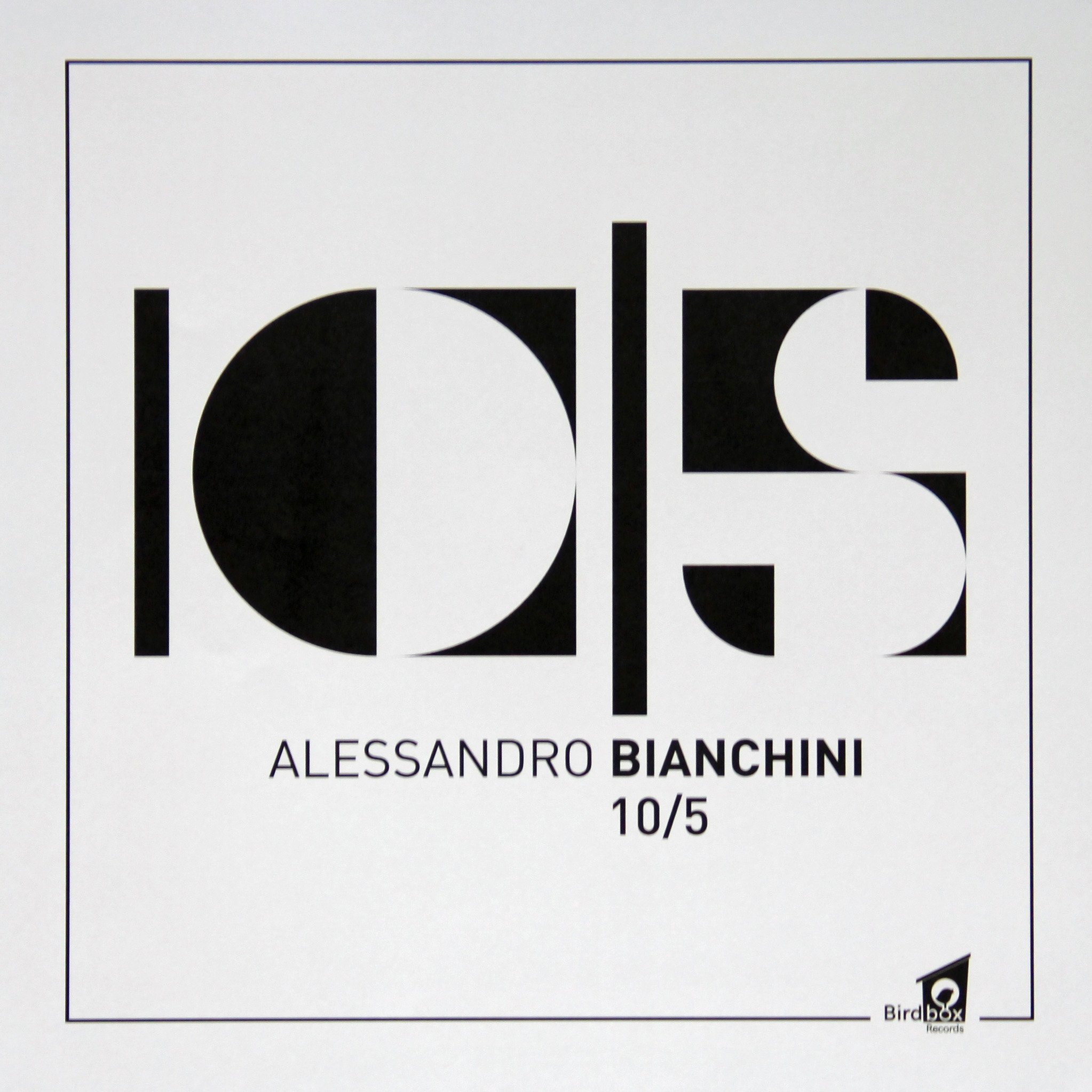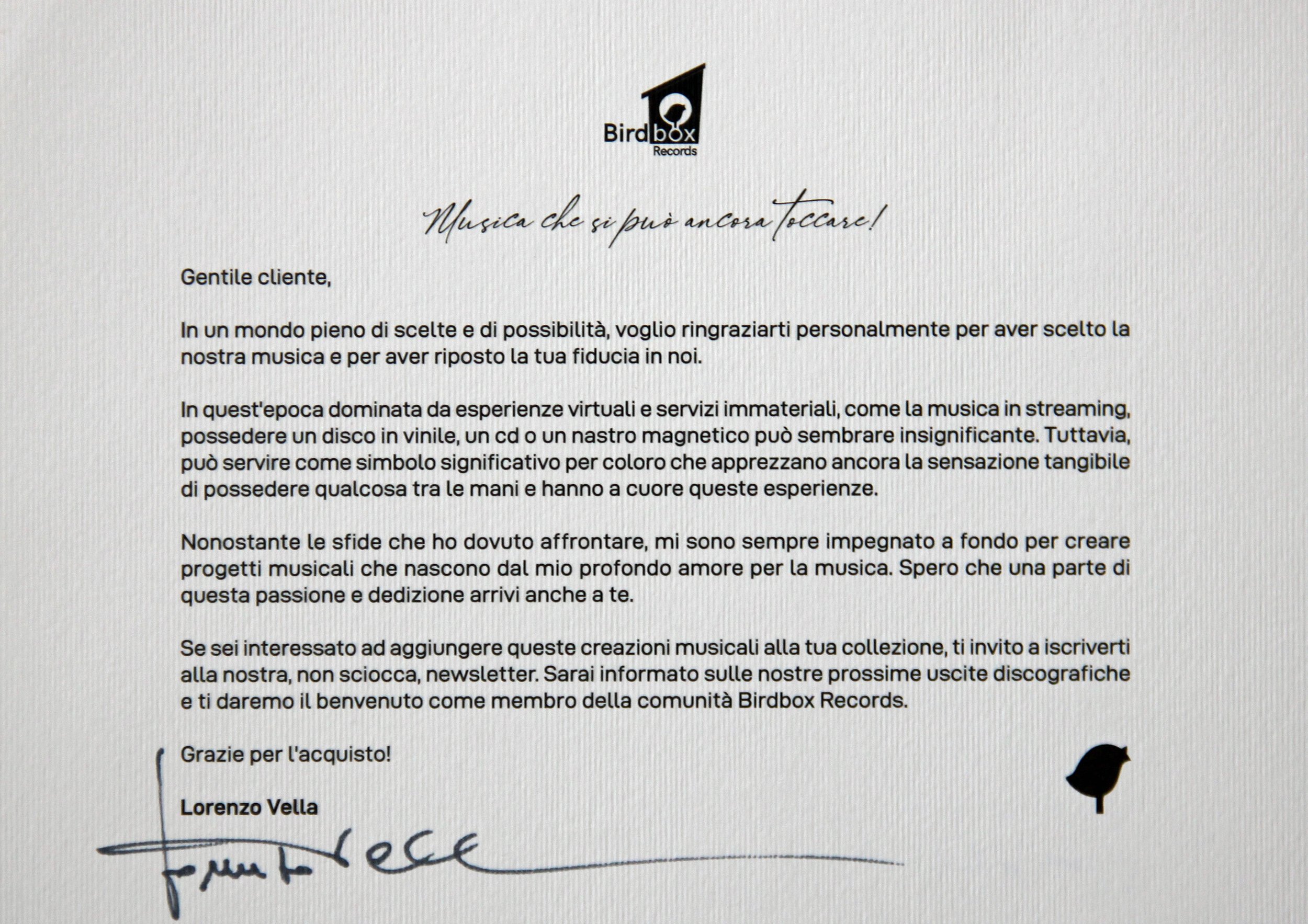Alessandro Bianchini - 10/5
Publisher: Birdbox Records, Nr. BBR2023AB01RMT
Playing time: 30 min
Specifications: half track ¼“, stereo, 38 cm/s, RTM SM900, 320 nWb/m, CCIR, 38 cm/s
Reel(s): 1 standard metal reel, with stickers
Packaging: 1 special cardboard box, printed, with spine labeling
Inserts: 3 information insert sheets, 2 printed on both sides
Homepage: https://birdboxrecords.com/
Author: Claus Müller
Below the English translation you will find the Italian translation
- - - > Sotto la traduzione in inglese troverete la traduzione in italiano < - - -
Imagine on the stage of your stereo set playing right before your eyes a great vibraphone and marimba, 100% matched with impressive drums and a remarkable bass: welcome to the world of musicians Alessandro Bianchini, Simone Brilli and Marco Micheli. Beatrice Sberna supports - albeit briefly - with her voice on two tracks. The recording took place in February 2023 at Andrea Scardovi's Duna Studio in Russi near Ravenna in Italy. A maximum of two takes per track were recorded by the trio. With a salute to the recording and mastering team: a really excellent job has been done here! For me, this means turning up the volume to the original level of the instruments and letting the music carry me. The tracks are pure jazz with improvisational elements embedded. They flow very well and are also suitable for beginners.
Alessandro Bianchini's musical world revolves around rhythmic and tonal relationships. For this album, for example, he arranged jazz classics from the bebop era, see the titles "Invitation" and "Bud Powell". He composed five of the seven songs himself. On "Song for Peace," his classical training shines through, as melodic elements of Johann Sebastian Bach's music were woven in. Bianchini cites Bill Evans, Scott LaFaro, Paul Motian, Charlie Parker, Bud Powell, Egberto Gismonti, and Chick Corea, to whom the Latin jazz borrowings of the title track "Grazie Armando" can be attributed, as influential figures in his work. So, in his music, different genres unite. I particularly like that Alessandro Bianchini goes ahead with a great lightness and a considerable wealth of ideas. His wording: "The timbral choice of the mallets that change according to the song, the idea of putting vibraphone and marimba together, and the almost maniacal emphasis on dynamics are the elements that, in my opinion, give the record a jazzy sound, with important and recognizable deliberately refined elements. Another aspect is certainly evident to listeners, namely the presence of an element that I personally always place in the foreground and that is the basis of improvisation and interplay: Timing. It is precisely the timing that allowed me to create a natural, almost instinctive feeling with the other members of the group: Marco Micheli on double bass and Simone Brilli on drums".
The album 10/5 of the young Alessandro Bianchini is, compared to other productions, a very good example of how much you can express musically in half an hour. For me it is a perfect and compact album, where so much is right. The trio gets my top marks. The overall quality of music, recording and mastering is what the world of master tape copies has to measure up to. I played this tape to my recent visitors. These were high fidelity freaks, newcomers to the subject of music reproduction, an orchestra musician and people who had little contact with audiophile reproduction of master tape copies so far. Everyone remained seated as if spellbound from the first to the last minute and was very impressed. Nobody started talking during the half hour. I'm sure you understand what I mean when I talk about a very special quality feature in this context. As the only point of criticism I would like to mention the vocal interludes, which for my taste do not really want to fit into the musical events. But since it is only a few minutes, it would not be appropriate to devalue the album because of that in the overall context.
For more information about the studio and the equipment of the tape package, please read the review "Umberto Fiorentino & Claudio Quartarone - Anamorfosi" on my homepage www.audiotapereview.com.
Translated from German with www.DeepL.com (free version)
- - - - - - - - - - - - - - - - - - - - - - - - - - - - - - - - - - - - - - - - - - - - - - - - - - - - - - - - - - -
Traduzione in Italiano
Immaginate un grande vibrafono e una marimba che suonano davanti ai vostri occhi sul palco del loro set stereo, abbinati al 100% a una batteria impressionante e a un basso notevole: benvenuti nel mondo dei musicisti Alessandro Bianchini, Simone Brilli e Marco Micheli. Beatrice Sberna supporta - seppur brevemente - con la sua voce in due brani. La registrazione è avvenuta nel febbraio 2023 presso il Duna Studio di Andrea Scardovi a Russi, vicino a Ravenna. Il trio ha registrato un massimo di due riprese per brano. Un saluto al team di registrazione e masterizzazione: qui è stato fatto un lavoro davvero eccellente! Per me questo significa: alzare il volume al livello originale degli strumenti e lasciarmi trasportare dalla musica. I brani sono puro jazz con elementi di improvvisazione incorporati. Scorrono molto bene e sono adatti anche ai principianti.
Il mondo musicale di Alessandro Bianchini ruota intorno alle relazioni ritmiche e tonali. Per questo album, ad esempio, ha arrangiato classici del jazz dell'epoca bebop, come i titoli "Invitation" e "Bud Powell". Cinque delle sette canzoni sono state composte da lui stesso. In "Song for Peace", la sua formazione classica risplende, poiché sono stati inseriti elementi melodici della musica di Johann Sebastian Bach. Bianchini cita come personalità influenti per il suo lavoro Bill Evans, Scott LaFaro, Paul Motian, Charlie Parker, Bud Powell, Egberto Gismonti e Chick Corea, a cui si possono attribuire i prestiti dal jazz latino nel titolo "Grazie Armando". Nella sua musica confluiscono così generi diversi. Mi piace particolarmente il fatto che Alessandro Bianchini proceda con grande disinvoltura e una notevole ricchezza di idee. Queste le sue parole: "La scelta dei timbri delle mazze, che cambiano a seconda del brano, l'idea di unire vibrafono e marimba e l'enfasi quasi folle sulle dinamiche sono gli elementi che, a mio avviso, conferiscono al disco un suono jazzistico con elementi importanti e riconoscibili, volutamente raffinati". Un altro aspetto sicuramente evidente all'ascoltatore è la presenza di un elemento che personalmente metto sempre in primo piano e che è alla base dell'improvvisazione e dell'interplay: il timing. Proprio il timing mi ha permesso di creare un feeling naturale, quasi istintivo, con gli altri membri del gruppo: Marco Micheli al contrabbasso e Simone Brilli alla batteria".
Rispetto ad altre produzioni, l'album 10/5 del giovane Alessandro Bianchini è un ottimo esempio di quanto si possa esprimere musicalmente in mezz'ora. Per me è un album perfetto e compatto in cui c'è molto di giusto. Il trio ottiene il massimo dei voti. Il mondo delle copie master su nastro deve essere misurato con la qualità complessiva della musica, della registrazione e della masterizzazione. Ho fatto ascoltare questo nastro ai miei recenti visitatori. Erano fanatici dell'alta fedeltà, neofiti della riproduzione musicale, musicisti d'orchestra e persone che avevano pochi contatti con la riproduzione audiofila di copie di nastri master. Tutti sono rimasti seduti come incantati dal primo all'ultimo minuto e sono rimasti molto colpiti. Nessuno ha iniziato a parlare durante la mezz'ora. Sono certo che capirete cosa intendo quando parlo di una qualità molto speciale in questo contesto. L'unico punto di critica che vorrei menzionare sono gli intermezzi vocali, che per i miei gusti non vogliono proprio inserirsi negli eventi musicali. Ma trattandosi di pochi minuti, non sarebbe opportuno svalutare l'album nel contesto generale per questo motivo.
Per maggiori informazioni sullo studio e sull'equipaggiamento della confezione del nastro, leggete la recensione "Umberto Fiorentino & Claudio Quartarone - Anamorfosi" sulla mia homepage www.audiotapereview.com.
Tradotto con www.DeepL.com/Translator (versione gratuita)
Music:
Sound:
The entire content and the individual elements of the web page are the intellectual property of Claus Müller and are subject to copyright protection. They may not be copied or imitated in whole or in part by the user; this applies to texts, logos and image components. Any modification, duplication, distribution or reproduction of the website or parts thereof, in any form whatsoever, is not permitted without the prior written consent of Claus Müller.
Der gesamte Inhalt und die einzelnen Elemente dieser Webseite sind geistiges Eigentum von Claus Müller und unterliegen dem Schutz des Urheberrechts. Sie dürfen vom Nutzer weder kopiert noch im Ganzen oder in Teilen imitiert werden; dies gilt insbesondere für Texte, Logos und Bildbestandteile. Jegliche Veränderung, Vervielfältigung, Verbreitung oder Wiedergabe der Webseite sowie Teilen hiervon, gleich welcher Art, ist ohne vorherige schriftliche Zustimmung von Claus Müller nicht zulässig.







